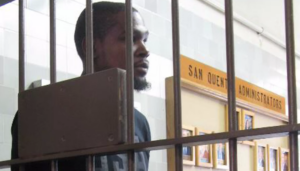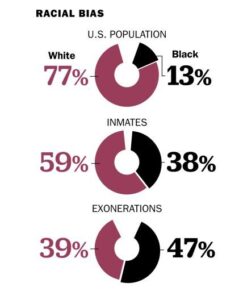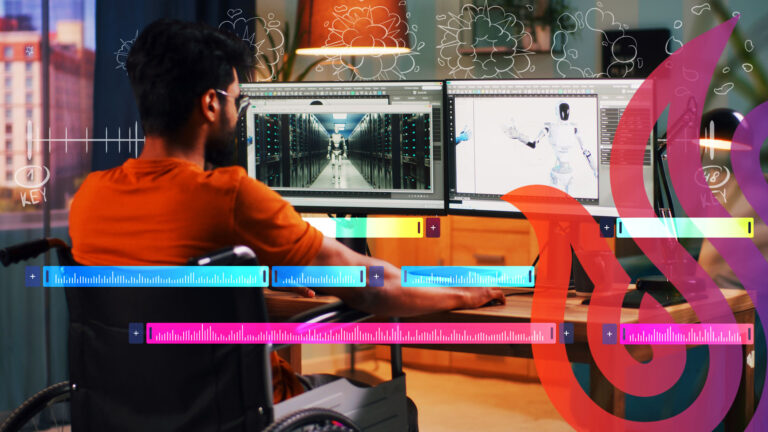In addition to her adjunct faculty role at USV and writing for Teen Vogue, Tamryn Spruill looks at sports from a unique perspective. This article was originally published by Golden State of Mind | Vox Media. The following version is lightly edited…
The Golden State Warriors have won two NBA Championships in three consecutive NBA Finals against the Cleveland Cavaliers. Lesser known, however, is Golden State’s winning record against the San Quentin Warriors: four games in the five years the league’s best team has visited San Quentin State Prison.

While the Golden State Warriors were preparing for Game 3 of the NBA Finals against the Cavs on the afternoon of June 7th, NPR’s All Things Considered aired a seven-minute segment featuring coverage by The Kitchen Sisters Present — in association with Life of the Law and reporter Nancy Mullane — of Golden State’s latest visit to San Quentin to play a game against the San Quentin Warriors.
The clip focused on the fun of the game and what the yearly meeting means for both the millionaire basketball stars and prisoners. The excitement in the prisoners’ voices — most of whom are serving life sentences for murder and have been imprisoned for decades — shows they probably had been looking forward to this event all year. The original Kitchen Sisters’ production takes on a somber tone when Draymond Green and Warriors’ general manager Bob Myers tour the facility.
By The Numbers
San Quentin Public Information Officer Sam Robinson walks Green and Myers through the North Block “housing unit,” where the “lifers” are held. More than 5,000 people are incarcerated at San Quentin, he says. Immediately, Green — who grew up in Saginaw, Michigan and states that he has friends who are imprisoned — comments on the size of the cells, stating that they’re “too small” and “the smallest rooms, if you will, that I’ve ever been in.” As a 6’7”, 230-pound NBA power forward, surely many rooms would feel “too small” for Green. But Robinson then quotes the dimensions: 4’ x 9’.
“There’s guys in here my size or bigger,” Green says. There are two inmates per cell.
To write this piece, I listened to the podcast several times. With each listen, these numbers sent chills down my spine:
- 15 years into a 102-years-to-life sentence, from a man who murdered someone at age 16
- 17 years into a 25-years-to-life sentence from a man who said being in San Quentin provided him with “a whole new respect for authority”
- 22 years into a life sentence for a man who did not provide any other identifying information
- 28 years into a life sentence for a man who identified himself as Michael Ware and stated he was up for parole “next week”
- At the time of publication, an inmate by the name of Michael Ware at San Quentin could not be located in public parole board records to determine if this inmate’s parole had been granted or denied.
These are human beings who have spent an entire lifetime behind bars, and many of them will die there, too.
A common response to discussions of mass incarceration is- “Don’t do the crime if you can’t you do the time”. Yes, illegal actions have consequences, and those who commit heinous crimes — or who are likely to become repeat offenders and pose a great threat to public safety — should be removed from society. But when discussing these lengthy prison terms, we also must ask questions, like:
Should teenagers be tried as adults and sentenced to life terms?
In general, the scientific community believes the human brain is not considered fully mature until age 25. This inherently means a person younger than 25 is still impressionable, capable of learning new things and able to modify behavior. If this is true, why are teenagers and young adults not being granted the chance to turn their lives around with rehabilitative support that includes counseling, education and work training?
In addition, phrases like “It wasn’t me or I didn’t do it” are often joked about as something all inmates say. But soaring exoneration rates of those who were falsely accused and wrongly convicted point to disturbing realities about the inconsistency and inefficiency of the criminal-justice system. According to the National Registry of Exonerations, “[a] total of 166 wrongly convicted people whose convictions date as far back as 1964 were declared innocent in 2016,” which amounts to approximately three exonerations per week.
Sadly, Draymond Green was right when he said during his tour of San Quentin, “At the end of the day, you know, whether you want to believe it or not, everybody’s one second away from here.”
According to the Southern Poverty Law Center, the U.S. population makes up only five percent of the world’s population yet, the country has 25 percent of the world’s prisoners. When put into the context of countries with less democratic societies, like Russia, China, and North Korea — where people can be sent to prison camps or killed for a simple tweet criticizing the government — this number should be startling to all Americans.
And it is African Americans who get the worst of the U.S. criminal-justice system.

As reported by time.com in a piece called “The Wrongly Convicted“, a study by the National Registry of Exonerations revealed that an astonishing number of African Americans were exonerated because members of this racial group, above all others, are arrested and convicted at higher rates. Despite making up just 13 percent of the U.S. population, blacks make up 38 percent of the prison population compared to just 59 percent of whites, who make up 77 percent of the country’s population.
The majority of exonerated African Americans were found to have been wrongly convicted because of faulty drug testing by police departments, lack of DNA evidence at the time of incarceration and incorrect witness identification.
This is not a hit-or-miss, random issue — it is a systemic one.
On average, innocent prisoners had almost nine years stolen from their lives before they were freed, and roughly 22 percent of prisoners have been exonerated by DNA evidence. But six percent of individuals who were exonerated had been serving time on death row and easily could have been put to death before cleared of charges. Unacceptably, 19 people were declared innocent after they died. The vast majority of overturned convictions in 2016 were for drug crimes.
Finally, one in three inmates determined to have been wrongly convicted had been sentenced to prison terms of 50 years or longer. Without the ability to afford good legal counsel and knowing the system is stacked against them, 18 percent of people who were exonerated had pleaded guilty to grab a shorter prison sentence even though they were innocent.
Capital Punishment
Another issue that has become increasingly problematic in recent years is the application of the death penalty. Most sane individuals would agree that a crime does not get more heinous than the brutal rape and murder of a three-year-old girl. The state of Ohio — after a three-year break in executions to search for a combination of lethal-injection drugs that would hasten death and end accusations of “cruel and unusual punishment” following a death-row inmate who, in 2014, gasped and gurgled for about 25 minutes before dying — restarted executions last week.
First to be ushered into the death chamber was Ronald Phillips, the man who — at age 19 — committed the aforementioned abominable crime. His lawyers argued for a stay of execution on the grounds that he was a teenager when he committed the crime. Age 43 at the time of his execution last week, the appeal stated that Phillips “[now] bears no resemblance to that teenager” and that he had become “a good man, who was thoughtful, caring, compassionate, remorseful, and reflective.”
The lawyers stated that Phillips had tried to atone for “his shameful role in Sheila’s death,” and in his final remarks, he stated, “To the Evans family, I’m sorry you had to live so long with my evil actions.”
Understandably, the victim’s family does not forgive him.
But, once again, we must ask if teens should be sentenced to life in prison or condemned to death given what science and medicine have discovered about cognitive development. Additionally, Phillips confessed to the crime. But what about those who go to the death chamber proclaiming innocence who are, in fact, innocent?
The Innocence Project, which works to exonerate inmates who claim they were falsely accused and wrongly convicted, blames eyewitness testimony for a large number of false arrests and erroneous convictions. For many reasons, eyewitness accounts are inherently flawed because memory changes over time. Studies have proved that many struggle to correctly identify people outside of their ethnic group and the human brain can form inaccurate memories due to the trauma of life-or-death situations.
Many inmates wrongly convicted by eyewitness testimony, who have spent up to decades in prison, were exonerated through retroactive DNA testing, thanks to the work of the Innocence Project and similar organizations. Erroneous convictions not only steal people’s lives, they leave the public at risk. If the wrong person has been in prison for decades, how many crimes might the real perpetrator go on to commit while roaming throughout society, free? When it comes to the death penalty — which cannot be undone if a mistake is made — would it not be reasonable to require DNA proof of guilt before a death sentence is handed down?
Dollars and Sense
In the state of California, it now costs upward of $75,000 per year to house one prisoner. Taking into account that many taxpayers do not earn that much per year, but are stuck with the bill to keep a roof over prisoners’ heads, food in their bellies, gym equipment in their workout areas and televisions in their recreation rooms, it doesn’t seem fair, does it?
Put another way, according to the Los Angeles Times, it costs $2,000 more per year to house a prisoner in California than it does to pay for “tuition, fees, room and board, and other expenses” at Harvard University for one year! Additionally, the most recent state budget allotted the corrections department $11.4 billion, even though the number of inmates has fallen due to early-release programs to ease prison overcrowding. This exorbitant budget begs the question: where is the money going?
By contrast, teachers in the U.S., on average, spend $500 of their own money to stock their classrooms with supplies — which totals about $1.6 billion annually. Common sense tells us that better-funded schools will lead students down a path of success. They will be college-ready or prepared to enter the workforce because of having learned a trade in high school. With possibilities for further education or future employment, young people most definitely would be more inclined to resist the wrong roads that lead to incarceration.
As it is, teachers do not make big bucks, so the financial burden should not fall on their wallets. Yes, it should partially fall on the districts. But in underfunded schools in poor areas, schools would still be cash-strapped and prevented from providing the best education possible. Therefore, tax dollars must be invested in areas that will enable individuals to thrive, which breeds better citizens, reduces crime and lowers incarceration rates.
That the state of California is spending $11.4 billion on the prison system, while teachers nationwide are spending a collective $1.6 billion annually to provide supplies for their students, speaks volumes about our society’s priorities and motivations.
The United States of America is supposed to be a world leader on issues of human rights and an exemplar for democracy and invention. Yet, this country continually denies opportunity and education from the poor and people of color, which keeps the criminal-justice system a burgeoning business.
Not only is the criminal-justice system deeply flawed, the entire social structure — mired in systemic racism — is ingloriously vitiated. Until the elected officials and the voters who put them in office can accept that each citizen’s success improves the nation overall, the problems will remain. Sadly, bigotry and racism prevent many from acknowledging this truth let alone accepting it.
Words Matter
At the start of his tour with Draymond Green and Bob Myers, San Quentin Public Information Officer Sam Robinson refers to North Block as a “housing unit.” By the loosest of definitions, San Quentin and any other prison could be considered a type of shelter or dwelling. But calling it a “housing unit” strips San Quentin — and all prisons — of their brutal reality: people stacked on top of one another, filthy conditions, racial segregation, violence, and deaths. The inmates live in cells in the same way that dogs live in cages in a shelter. To refer to them as making up a “housing unit” is the kind of PR spin that stifles discourse. A visual representation of the PR spin can be found on the San Quentin website, which very much resembles a website for any state park … as if San Quentin is a pleasant place people should want to visit on vacation.
Meanwhile, towards the end of the tour, Bob Myers notes that many of the inmates “grew up in the wrong place” and “made the wrong decisions.” This, in juxtaposition to his upbringing in Alamo, CA, where he perhaps knew one person who went to prison. Although clear and well-meaning, declaring any community “the wrong place” is somewhat problematic. Children do not have a say in their births or the communities into which they are born. Babies do not select the color of their skin or the type of society they enter into when pushed from the womb.
“The wrong place” is all many people are able to call home, and what becomes of their lives often is the result of the disenfranchisement that comes with poverty and having black or brown skin. This is not about people having a victim mentality, but a society that stacks the deck against certain groups of people who, then, have to overcome numerous obstacles for a chance at a decent life.
In such a scenario, success becomes a rarity and a life of crime (for individuals who did not have the benefit of good schools and have limited-to-no employment prospects) becomes the norm. Thus, the inequities in the criminal-justice system will remain so long as society is mired in systemic racism.
Kevin Durant, Draymond Green and Bob Myers took the trip to San Quentin for what appears to be two distinct reasons:
- To deter people from the type of poor decision-making that can land them in prison
- To draw attention to the U.S. mass incarceration crisis.
Unfortunately, much of mainstream media opted to ignore this story.
Team Effort
In addition to playing hoops at San Quentin, Kevin Durant is also known for his Nike Equality commercial and generous civic involvement, while Draymond Green has supported the Sideline Racism campaign and spoken out on other issues.
But they are not the only Warriors to support important causes and to be vocal about social justice issues. As has been widely covered at Golden State of Mind, there are other members of the Golden State Warriors’ organization who have helped their communities over the last year:
- Stephen Curry: The greatest shooter on the planet has spoken publicly about his concern for his Under Armour boss’s support of Donald Trump. He also auctioned shoes for a hefty sum to support Ghost Ship recovery efforts.
- Andre Iguodala: The dry-witted former NBA MVP has spoken about double standards concerning race and the concerns he has living as a black man in this society. He has also served as a financial mentor to younger NBA players to help them keep their cash and secure their futures.
- Steve Kerr: The “Zen coach” has spoken vehemently against the negative rhetoric of Donald Trump, as well as the police killings of African-American men and Colin Kaepernick’s activism.
- David West: Spearheaded by his wife Lesley, and going back a few cities and teams, West has supported Dressed by West to bring prom dresses to young women in poorer communities who otherwise would not be able to afford them.
Citizens do not need to be athletes to be activists, and money is not required. So, consider where this society would be if every time someone sent a tweet of complaint about a social issue, the person also backed the talk with action. Consider that every day we create our destiny — as individuals and as a collective society — with the choices we make. Remember that the tiniest pebble still makes a ripple.
And kindness is badass.


